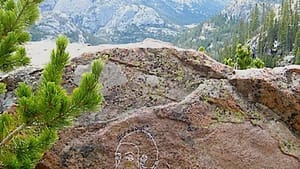Stay in the Loop
BSR publishes on a weekly schedule, with an email newsletter every Wednesday and Thursday morning. There’s no paywall, and subscribing is always free.
The impulse to defile
Vandalism in the national parks

When is it art, and when is it vandalism? That was the question posed a couple of generations ago when our cities began to fill up with graffiti on every available surface. You got the message: It was part urban aggression against property that other people owned or common space that you wanted to mark off symbolically for yourself; it was artistic expression that defied conventional rules of the properly decorous sites in which it could be exhibited.
For some, it jazzed up drab temples of commerce and made the downtown scene livelier, quirkier, at once more dangerous and more inviting. At the same time, it wasn’t hammer-and-tong, fire-next-time destruction; it wasn’t a riot, or, if it was, it was one in slow motion. City fathers in various places — Philadelphia notable among them — sought to preempt or domesticate graffiti by making wall spaces available for approved artists. It would spruce up the slums, give quasi-official license to popular rebellion (if that’s what it was to be called), and mark the Rittenhouse Squares and Fifth Avenues of the rich as off-limits to decoration.
The graffiti movement leveled off; the ghetto murals — well- or ill-done — remained as semi-permanent features of the city environment, and commercial advertisers, the original polluters of civic spaces, moved in to cover buses and trains with their eyesores. The worst of all barbarisms won out — defacement in the name of profit. As a parable of America, it had a certain inevitable symmetry. The rebels move out; the retailers move in. The buck prevails.
Libido for the ugly
Cities are one thing; the wide open spaces are another. H. L. Mencken once remarked that Americans have a “libido for the ugly;” it was the only way he could account for the particular combination of the drab and the garish that characterized American cities. Robinson Jeffers, thinking of humanity in general, said it "would shit on the North Star" if it could reach it.
 There was a counter-impulse to this, which still doesn’t have a name as good or snappy as the one Mencken offered for the uglification of our cities. It could be seen in the American landscape painting of the 19th century, with its depictions of a majestic nature — soaring peaks, glorious sunsets — unsullied by human presence. The discovery of such wonders as Yosemite and the nature writings of John Muir and others crystallized the movement to preserve wilderness through a national park system. The idea — quite amazing, if you think about it, in our commercial republic — was to set aside some of the national real estate as imaginary cathedrals that no man would necessarily enter but that we could all possess as a mental refuge from ourselves.
There was a counter-impulse to this, which still doesn’t have a name as good or snappy as the one Mencken offered for the uglification of our cities. It could be seen in the American landscape painting of the 19th century, with its depictions of a majestic nature — soaring peaks, glorious sunsets — unsullied by human presence. The discovery of such wonders as Yosemite and the nature writings of John Muir and others crystallized the movement to preserve wilderness through a national park system. The idea — quite amazing, if you think about it, in our commercial republic — was to set aside some of the national real estate as imaginary cathedrals that no man would necessarily enter but that we could all possess as a mental refuge from ourselves.
#creepytings
Of course, that idea wasn’t going to hold, and the national parks now annually receive 280 million visitors, or nearly the population of the United States. Their environments are stressed, and their borders are encroached on. There’s a lot of trash to be hauled out, and arsonists make it their playground. Some jokers decided not long ago to amuse themselves by toppling a picturesque rock formation for the hell of it. But now a still-unidentified woman from New York State (who signs her handiwork with the hashtag #creepytings) has reformulated for us the question posed by graffiti artists in the cities: When is art vandalism?
The woman in question took a trip through some particularly cherished sites, including stops in Yosemite, Sequoia, Kings Canyon, Death Valley, Crater Lake, Bryce Canyon, and the Grand Canyon. She left behind very large drawings in acrylic and magic marker on rock formations, and she proudly posted some of them on Instagram and Tumblr. Her talent seems to be inversely proportional to her vanity; one such drawing depicts a woman’s face in profile, sketched in red, with blue hair piled up in a bun. This particular sample was done at an altitude of 9,000 feet, presumably to give God a good look at it. I’m sure it will be great fun to erase.
Of course, environmental art has a very ancient pedigree: cave paintings; the Nazca in Peru; the Long Man of Wilmington in South Downs, Sussex; and so on down to modern pranksters like Christo or genuine artists like Richard Hamilton. Then there’s the question of desecration versus decoration, posed most famously by Duchamp in giving the Mona Lisa a mustache. He put it on a reproduction, to be sure, but characters who’ve defaced actual works of art have also claimed artistic license: After all, is a work of art ever truly finished when someone thinks he or she can improve on it with a knife?
“Drawing” the line
So, where to draw the line? When Duchamp decided to exhibit a urinal as a work of art, or for that matter when people refer to a mountain range as God’s handiwork, the question of what constitutes a work of art is posed in radical form. Does it require, to begin with, some level of conscious intention, and does that create questions of deliberate expression, and, ultimately, of ownership and, therefore, exclusivity? Does the Mona Lisa have a right not to have a mustache painted on it in fact? Is Yosemite itself a work of art, and, if so, who is the rightful owner? God? The American commons? Are we the owners of Yosemite or simply its custodians, and, if the latter, for whom or what do we keep custody except for ourselves?
I guess we should thank the lady from New York for reframing these questions for us. Personally, I don’t have any difficulty in defining what she did as vandalism. I’d have felt the same if Picasso or Matisse had taken the trip she did and left similar specimens of their art behind. It would take a longer space than I have here to explain why, but suffice it to say that while there isn’t anything we can’t admire, there are things we shouldn’t touch. It isn’t just a matter of leaving well enough alone. There needs to be space between ourselves and the world, call it sacred if you like, without which chaos is come. And we have violated enough of that space already.
Above right: Albert Bierstadt, Yosemite Valley, Yosemite Park, 1868. Oakland Museum.
Sign up for our newsletter
All of the week's new articles, all in one place. Sign up for the free weekly BSR newsletters, and don't miss a conversation.

 Robert Zaller
Robert Zaller